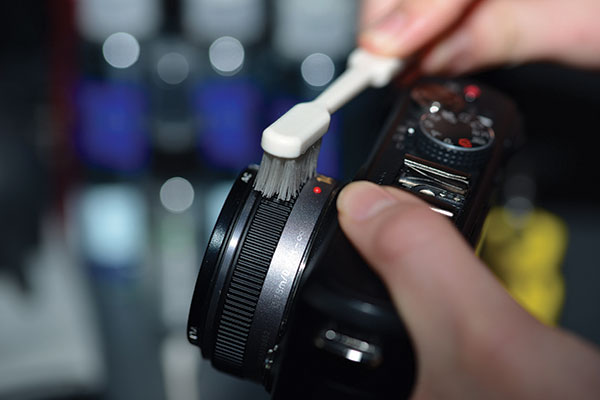Is Your Camera Shiny or Grimy?: How to Get Your Gear Cleaned Up and Ready For Sale

All Photos © Jon Sienkiewicz
You’d wash your car inside and out before you tried to sell it, right? At the least you’d vacuum the dog hair from the back seat. Why do so many people offer downright dirty cameras and lenses for sale at online auction websites? While you cannot (and should not) remove signs of wear, you can easily make used gear clean and presentable.
Tools
Here’s what you need: a bright light or pocket flashlight. One 8x loupe magnifier—the kind we once used to scrutinize negatives and slides.
Two plush microfiber cloths—one for general cleaning and one reserved for glass surfaces only. At least one clean soft brush, and one clean toothbrush (the cheap kind with soft, straight-cut bristles). A large, hand-operated bulb-type air blower (avoid compressed air). A handful of cotton swabs. A bottle or two of high-grade lens cleaner (I use Zeiss and Purosol, but there are others). And for experts only, denatured alcohol.
Inspect
Remember that close, magnified examination of a digital image of an object often reveals more than what’s seen when the naked eye looks at the actual item. Solution? Carefully examine the equipment with an 8x loupe and a bright light.
What makes cameras dirty? Hands. Look for places where dirty fingers are likely to leave grease and grime, especially the areas around the shutter release, jog dial, and all buttons. The parallel grooves on lens barrels always collect dust and debris. Ditto aperture rings and some control dials.

Carefully Clean Metal
Wipe all surfaces with a plush microfiber cloth. Lens barrels can be groomed with a soft-bristled toothbrush. Crevices around buttons and dials are more easily cleaned with a dry cotton swab (Q-tip). Resist the temptation to moisten the swab; use patient persistence instead of liquid. Reexamine the camera and continue cleaning as necessary.
While you’re scrubbing up the outside of the camera, check the battery compartment, memory card slot, and all other openings. These generally require no special care, but if you notice corrosion you must disclose this in your auction description.

Glass: Clean With Caution
I’ll take a dirty lens over a scratched one any day. In other words, exercise caution when cleaning the optics. Use the clean microfiber cloth on the LCD and viewfinder window, then gently use the blower and soft brush on the front element. If you find a fingerprint or greasy smudge, use a drop of lens cleaner applied to a lens tissue (never directly on the lens) and wipe with a circular motion. Facial tissues can contain fragrances and softeners that are harmful to lens coatings—never use them to clean a lens. Yes, fogging the lens with your breath and then wiping is often sufficient, unless you are a dragon or prone to fits of sneezing. Do not clean the rear element, but inspect it for scratches and coating separation.
Do Not Clean The Sensor
If you feel absolutely compelled to clean the sensor, take a nap until the urge subsides. If that doesn’t work, hold the camera with the lens opening facing the ground at a 45-degree angle and gingerly use the bulb blower to expel the dust. Do not stick the nozzle of the blower inside the camera. Do not use compressed air or your breath.
When you photograph the camera, leave the body cap on. So many sellers feel obligated to show the camera with the sensor exposed, but that’s not very smart. Why expose the camera’s innards and imaging sensor to airborne contaminants? There is no way the buyer could visually inspect the exposed sensor from that tiny photo, anyway. And it could make the potential buyer think that you’re selling the camera without the body cap (and shipping it with the sensor exposed).

Final Touch
When you’re satisfied that the equipment is clean, give it one final wipe down with the soft brush just before you photograph it. This process removes the late-arriving dust and such and is worth the 15 seconds required to perform.
Overall, use a light touch and appropriate caution. If you lack the dexterity required to thread a needle, better leave the cleaning to a professional camera repairman.
- Log in or register to post comments












































